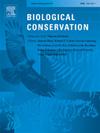生物入侵正在侵蚀世界各地岛屿爬行动物的独特组合
IF 4.9
1区 环境科学与生态学
Q1 BIODIVERSITY CONSERVATION
引用次数: 0
摘要
岛屿生态系统因其特有生物种类较多而具有重要的保护价值。此外,比较岛屿和大陆物种组成差异(物种差异性)的区域群落研究表明,岛屿上的群落组合与大陆上的群落组合不同。然而,在全球范围内对岛屿生物组合的独特性研究很少,在这些模式中也没有考虑系统发育信息或外来物种。我们利用全球岛屿和邻近大陆地区的爬行动物,评估了从一个群落到另一个群落的分类和系统发育变化,重点是大陆-大陆(M-M)之间物种组成的差异,以及大陆-岛屿(M-I)之间和岛屿-岛屿(I-I)之间物种组成的差异。我们的分析发现,与 M-M 模型预测的结果相比,M-I 和 I-I 比较的分类学和系统发育差异更大,这表明全球岛屿爬行动物的集结模式与大陆爬行动物的集结模式不同。然而,在考虑了外来物种之后,这种较高的 M-I 差异性明显降低。我们的研究结果从岛屿生物集结的分类学和系统发育独特性两方面为岛屿生物多样性保护的重要性提供了全球性证据。本文章由计算机程序翻译,如有差异,请以英文原文为准。
Biological invasion is eroding the unique assembly of island herpetofauna worldwide
Island ecosystems have significant conservation value owing to their higher endemic biotas. Moreover, studies of regional communities that compare differences in species composition (species dissimilarity) among islands and the mainland suggest that community assembly on islands is different from that on the mainland. However, the uniqueness of island biotic assembly has been little studied at the global scale, nor have phylogenetic information or alien species been considered in these patterns. We evaluate taxonomic and phylogenetic change from one community to the next, focusing on differences in species composition between mainland-mainland (M-M) pairs compared to differences between mainland-island pairs (M-I) and between island-island pairs (I-I), using herpetofauna on islands and adjacent mainland areas worldwide. Our analyses detect greater taxonomic and phylogenetic dissimilarity for M-I and I-I comparisons than predicted by M-M model, indicating different island herpetofauna assembly patterns compared with mainland counterparts across the world. However, this higher M-I dissimilarity has been significantly decreased after considering alien species. Our results provide global evidence on the importance of island biodiversity conservation from the aspect of both the taxonomic and phylogenetic uniqueness of island biotic assembly.
求助全文
通过发布文献求助,成功后即可免费获取论文全文。
去求助
来源期刊

Biological Conservation
环境科学-环境科学
CiteScore
10.20
自引率
3.40%
发文量
295
审稿时长
61 days
期刊介绍:
Biological Conservation is an international leading journal in the discipline of conservation biology. The journal publishes articles spanning a diverse range of fields that contribute to the biological, sociological, and economic dimensions of conservation and natural resource management. The primary aim of Biological Conservation is the publication of high-quality papers that advance the science and practice of conservation, or which demonstrate the application of conservation principles for natural resource management and policy. Therefore it will be of interest to a broad international readership.
 求助内容:
求助内容: 应助结果提醒方式:
应助结果提醒方式:


